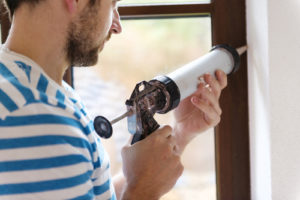 Of the many places in an average home where air leaks and energy loss can occur, windows are among the most susceptible to problems that can reduce whole-house efficiency. Fortunately, windows are also among the easier areas to address when you’re looking for ways to stop energy loss, increase efficiency and reduce your overall energy expenses. Here are some techniques for weatherizing windows that will boost efficiency throughout your home and cut down on wasted air and energy.
Of the many places in an average home where air leaks and energy loss can occur, windows are among the most susceptible to problems that can reduce whole-house efficiency. Fortunately, windows are also among the easier areas to address when you’re looking for ways to stop energy loss, increase efficiency and reduce your overall energy expenses. Here are some techniques for weatherizing windows that will boost efficiency throughout your home and cut down on wasted air and energy.
Evaluate Window Condition
Before starting on a project of sealing and weatherizing windows, make sure the windows are worth the effort to seal and repair. If the windows are old, in bad condition, or unlikely to be a good candidate for sealing, consider replacing them with new windows instead of wasting resources on a sealing job that probably won’t be effective. If in doubt, ask your construction or remodeling professional for advice.
Seal Windows Against Air Leaks
Air leaks around windows, frames and casings are one of the most common sources of energy loss associated with windows. This should be your first area of attention as you work to improve whole-house efficiency through weatherizing windows. Check for cracks, gaps, holes or other openings around the window frame and casing and seal them with silicone caulking. This will eliminate a major source of drafts where cold air can escape in the summer and get inside during the winter. Seal around the glass panes in the window itself with clear silicone caulking.
Apply Shrink Film
Shrink film can be applied directly to windows to help block air leaks while still allowing you to easily see through windows. This film is usually attached at the edges of the window with double-sided tape, then stretched over the surface of the window. When heat from a blow dryer or other source is applied, the film shrinks and creates a tight seal over the window that keeps out drafts and stops air and energy leaks.
Attach Weatherstripping
Weatherstripping is a type of draft-blocking material, usually made of rubber or foam, that’s attached to windows to seal openings where the window opens and closes. The most effective weatherstripping will create an airtight seal that prevents air leaks. Make sure the window can still open and close properly after the weatherstripping is applied.
Repair or Replace Cracked Panes
Cracked or broken panes could be a problem in some windows, especially older ones. If the panes are severely damaged or broken, they’ll need to be replaced. Your local hardware store or window store should be able to cut glass to fit and replace it within the frame. This may involve the need to remove the windows and take them into a workshop for repair. Small cracks in window panes can be sealed with a material such as clear nail polish to stop air leaks.
Use Draft Blockers
Draft-blocking objects such as draft snakes are usually made of a cloth tube stuffed with foam, more cloth, or another type of insulating, draft-stopping material. These portable blockers can be easily moved around and stuffed into areas at the bottom of windows and doors where drafts are most likely to occur. They seal out the drafts and prevent indoor air from leaking out through gaps or openings at the bottom of these structures.
Install Insulated Curtains
Consider adding insulated curtains to windows where drafts and air leaks are more likely to occur. These types of curtains create an insulating barrier over windows that helps prevent either cold or heat from migrating from the window and into your home’s interior. The side of the curtains that faces the window usually has an insulating layer of high-density foam that blocks heat transfer, which is beneficial in both winter and summer. The outer parts that face the room present a decorative face equivalent to any other type of curtains.
For more information on the benefits of weatherizing windows, check out Griffith Energy Services’ home comfort solutions or call 888-474-3391.
Image Provided by Shutterstock.com



